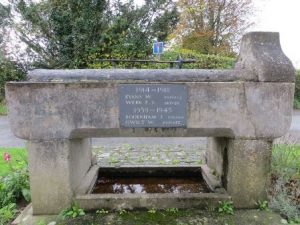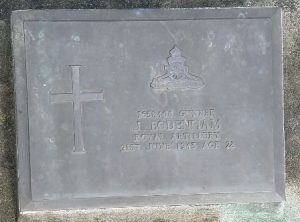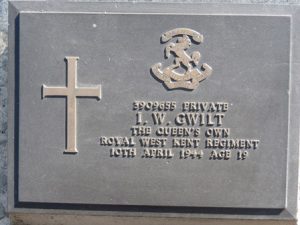Norton is a small village which lies on the B4355 road about two miles north of Presteigne, in the historic county of Radnorshire. Two men from the village fell during the Great War and another two during the Second World War, and are commemorated on the village war memorial, which takes the form of a horse trough and drinking fountain situated at Mynd Road, opposite St. Andrew’s Church. The inscription on the memorial reads: ‘This memorial is erected by the grateful village of Norton to commemorate the names of its faithful sons who fought and died for England and liberty’.

The Great War 1914-1918
William Thomas Evans, Private, 204658, Middlesex Regiment. William was the son of George and Ann Evans, of Tinker’s Gate, Cascob, Presteigne. He worked as a waggoner at Paradise Farm, Presteigne prior to enlisting into the army at Presteigne on 9 February 1917. After training William embarked at Folkestone for Boulogne on 13 September 1917 and was posted to the 20th Battalion, Middlesex Regiment. The battalion was attached to 121 Brigade, 40th (Bantam) Division and had been in France since June 1916. William joined the battalion in the field on 22 September, in time to take part in his first major action, during the Battle of Cambrai. The division took part in heavy fighting at Bourlon Wood, which was assaulted with tank support on the morning of 23 November and over three days of heavy fighting suffered over 4,000 casualties. The Germans counter-attacked at Cambrai quickly and the offensive ended in a struggle to maintain the Flesquières Salient and by 7 December the British had retreated to their original lines. The 40th Division wintered in the Cambrai sector and on 14 February 1918 William was admitted to hospital after his health had begun to break down, and he was diagnosed as suffering from Impetigo. He was treated and had a brief rest before re-joining his battalion, but was unfortunately caught up in heavy fighting soon after, when the Germans launched their Spring Offensive on 21 March 1918. The division fought a desperate rearguard action over the coming days before being evacuated from the front and moved to the Lys sector to rebuild. Unfortunately, the Germans launched the second phase of their offensive here on 9 April and the division again became caught up in desperate fighting. William was reported as missing on 11 April and was among a huge number of men taken prisoner by the Germans. He was taken to the POW camp at Limburg in Germany where he died of dysentery on 30 July 1918, aged 31. Oddly he is buried in Lille Southern Cemetery, France. There is no note of his grave being exhumed from Germany and re-buried in Lille, so did he die in Lille?
Ernest John Webb, Driver, T3/028078, Royal Army Service Corps. Ernest was born at Heyope, Knighton on 10 May 1889, the son of William Webb and Naomi Webb (nee Griffiths). He was educated at Heyhope School before becoming a Carpenter and by 1911 the family had moved to the Colony, Stonewall Hill, Norton. Ernest enlisted at Shrewsbury into the Army Service Corps on 7 November 1914 and was posted to France on 8 September 1915, where he became attached to the Royal Army Medical Corps. On 20 November 1917 he was with a group of men watering horses at Hersin when the Germans began shelling the area and a shell exploded over the men, killing them all. Ernest was 28 years old when he was killed that day, and is buried in Hersin Communal Cemetery Extension, France.
World War Two, 1939-1945
John Bodenham, Gunner, 1638466, Royal Artillery. John was born on 20 February 1915, the son of Lewis Bodenham and Edith Bodenham (nee Allen), of The Hazels, Norton. He worked as a timber hauler and contractor prior to enlisting into the Royal Artillery and was posted to the Far East with 241 Battery, 77 Heavy Anti-Aircraft Regiment, Royal Artillery. The regiment sailed from the Clyde on 6 December 1941 on Convoy WS14, and arrived at Batavia on 4 February 1942. Singapore fell to the Japanese on 15 February 1942, and the situation in the Far East was getting dire for the British. John’s Battery moved to Surabaja in Eastern Java and went into action against the Japanese a week before the fall of Singapore. John was probably captured at Surabaja soon afterwards, when the Battery became cut off and lost. He died in captivity on 21 June 1943, aged 28, and is buried in Ambon War Cemetery, Indonesia.

Ivor William Gwilt, Private, 3909655, Queen’s Own Royal West Kent Regiment. Ivor was the son of Edward Gwilt and Agnes Maria Gwilt (nee Higgs). He enlisted into the 4th Battalion, Queen’s Own Royal West Kent Regiment, a TA unit which was in France with the BEF in 1940, before being evacuated from Dunkirk. The battalion was attached to the 132nd Infantry Brigade, 44th (Home Counties) Division and embarked for North Africa in May 1942. The Division was disbanded in 1943 and the 4th Battalion was transferred to the 161st Indian Infantry Brigade in Burma. The battalion played a major role in the Battle of the Tennis Court, part of the larger Battle of Kohima, when the Japanese crossed the Chindwin River to invade India in 1944. Ivor was killed at Kohima, during the same action that Lance Corporal John Harman of the same Battalion was posthumously awarded the Victoria Cross, on 10 April 1944, aged 19. Ivor is buried in Kohima War Cemetery, India.
